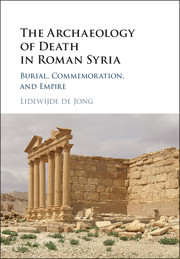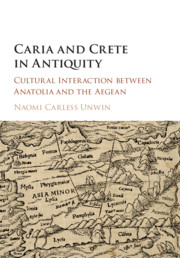Refine search
Actions for selected content:
23989 results in Ancient history
List of Abbreviations
-
- Book:
- The Archaeology of Death in Roman Syria
- Published online:
- 14 July 2017
- Print publication:
- 20 July 2017, pp xv-xvi
-
- Chapter
- Export citation
Contents
-
- Book:
- The Archaeology of Death in Roman Syria
- Published online:
- 14 July 2017
- Print publication:
- 20 July 2017, pp v-vi
-
- Chapter
- Export citation
5 - Funerary Beliefs: Differentiation, Continuity, And Change In Ritual
-
- Book:
- The Archaeology of Death in Roman Syria
- Published online:
- 14 July 2017
- Print publication:
- 20 July 2017, pp 146-174
-
- Chapter
- Export citation
List of Figures
-
- Book:
- The Archaeology of Death in Roman Syria
- Published online:
- 14 July 2017
- Print publication:
- 20 July 2017, pp vii-x
-
- Chapter
- Export citation
Bibliography
-
- Book:
- The Archaeology of Death in Roman Syria
- Published online:
- 14 July 2017
- Print publication:
- 20 July 2017, pp 339-362
-
- Chapter
- Export citation
4 - The Dead: Bones, Portraits, And Epitaphs
-
- Book:
- The Archaeology of Death in Roman Syria
- Published online:
- 14 July 2017
- Print publication:
- 20 July 2017, pp 102-145
-
- Chapter
- Export citation
3 - Gifts For The Dead: Function And Distribution Of Grave Goods
-
- Book:
- The Archaeology of Death in Roman Syria
- Published online:
- 14 July 2017
- Print publication:
- 20 July 2017, pp 77-101
-
- Chapter
-
- You have access
- Export citation
Appendix 1 - Sites
-
- Book:
- The Archaeology of Death in Roman Syria
- Published online:
- 14 July 2017
- Print publication:
- 20 July 2017, pp 225-313
-
- Chapter
- Export citation
1 - Locating The Dead: Space, Landscape, And Cemetery Organization
-
- Book:
- The Archaeology of Death in Roman Syria
- Published online:
- 14 July 2017
- Print publication:
- 20 July 2017, pp 20-36
-
- Chapter
- Export citation

The Archaeology of Death in Roman Syria
- Burial, Commemoration, and Empire
-
- Published online:
- 14 July 2017
- Print publication:
- 20 July 2017

Caria and Crete in Antiquity
- Cultural Interaction between Anatolia and the Aegean
-
- Published online:
- 13 July 2017
- Print publication:
- 13 July 2017
Index
-
- Book:
- Caria and Crete in Antiquity
- Published online:
- 13 July 2017
- Print publication:
- 13 July 2017, pp 258-266
-
- Chapter
- Export citation
References
-
- Book:
- Caria and Crete in Antiquity
- Published online:
- 13 July 2017
- Print publication:
- 13 July 2017, pp 231-257
-
- Chapter
- Export citation
Figures
-
- Book:
- Caria and Crete in Antiquity
- Published online:
- 13 July 2017
- Print publication:
- 13 July 2017, pp ix-ix
-
- Chapter
- Export citation
Preface
-
- Book:
- Caria and Crete in Antiquity
- Published online:
- 13 July 2017
- Print publication:
- 13 July 2017, pp xi-xiii
-
- Chapter
- Export citation
Copyright page
-
- Book:
- Caria and Crete in Antiquity
- Published online:
- 13 July 2017
- Print publication:
- 13 July 2017, pp iv-iv
-
- Chapter
- Export citation
2 - The Role of Crete in the Mythologies, Local Histories and Cults of Caria
-
- Book:
- Caria and Crete in Antiquity
- Published online:
- 13 July 2017
- Print publication:
- 13 July 2017, pp 61-90
-
- Chapter
- Export citation
Appendix 1: - I. Magnesia 17
-
- Book:
- Caria and Crete in Antiquity
- Published online:
- 13 July 2017
- Print publication:
- 13 July 2017, pp 213-216
-
- Chapter
- Export citation
1 - Articulating a ‘Carian’ Identity
-
- Book:
- Caria and Crete in Antiquity
- Published online:
- 13 July 2017
- Print publication:
- 13 July 2017, pp 32-60
-
- Chapter
- Export citation
A Note on Transliteration and Translation
-
- Book:
- Caria and Crete in Antiquity
- Published online:
- 13 July 2017
- Print publication:
- 13 July 2017, pp xiv-xiv
-
- Chapter
- Export citation
